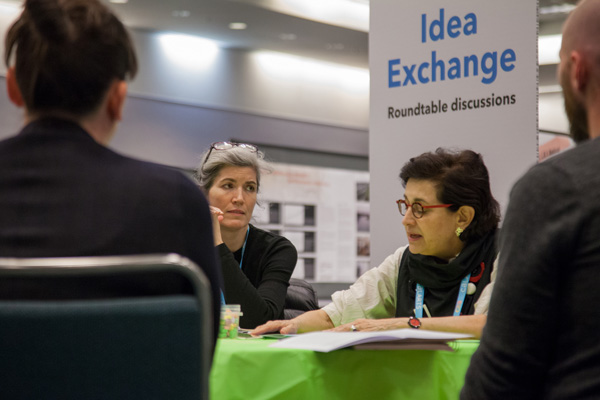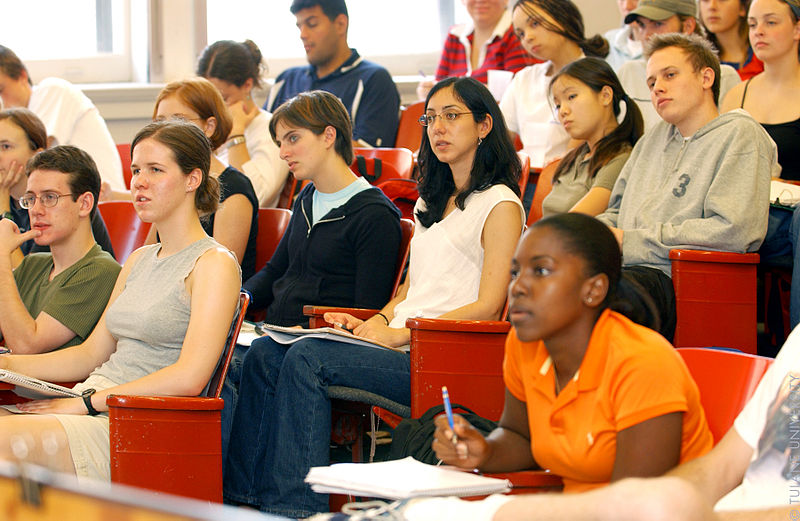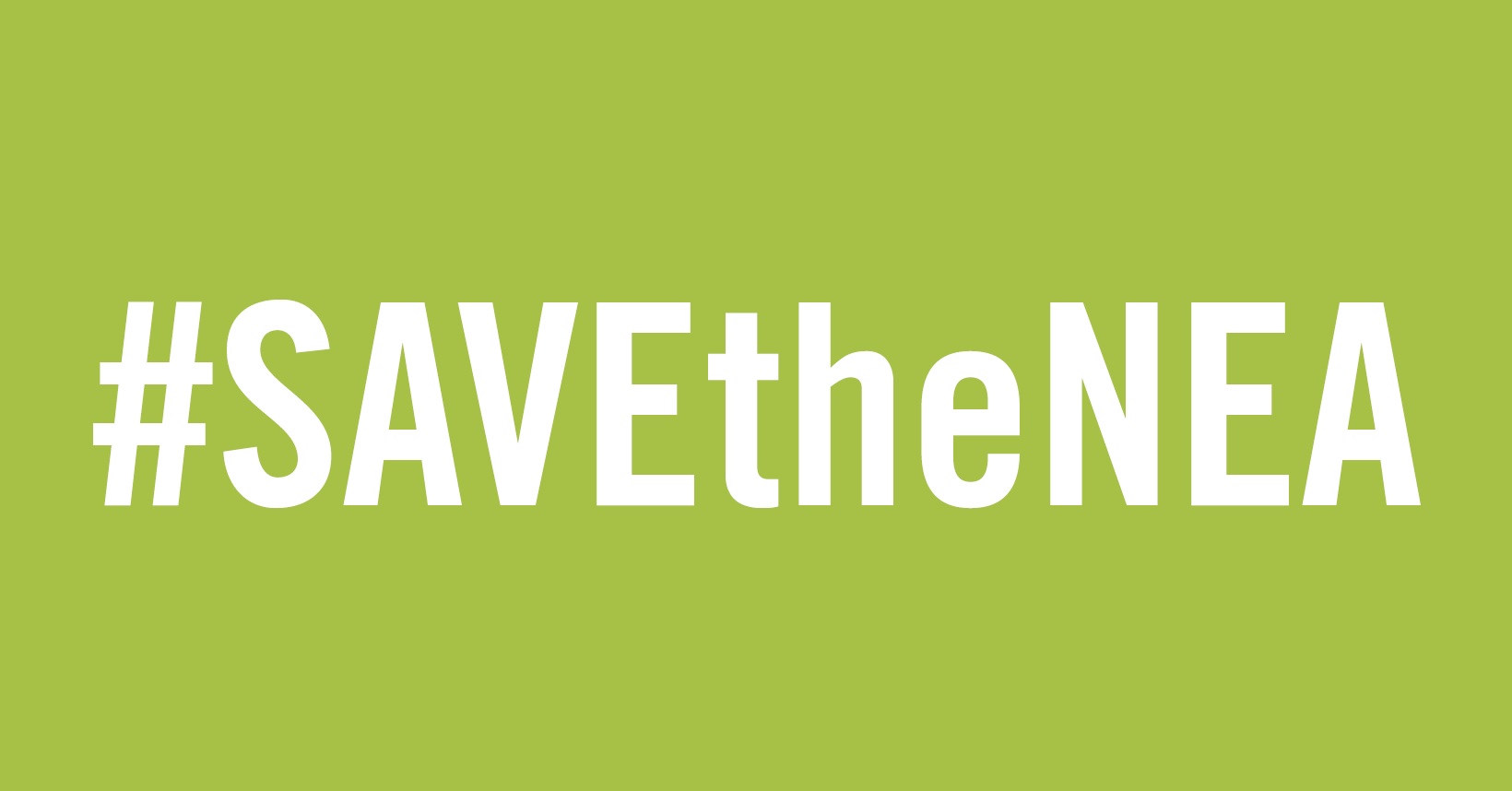CAA News Today
Support the Arts and Humanities
posted by CAA — November 05, 2018
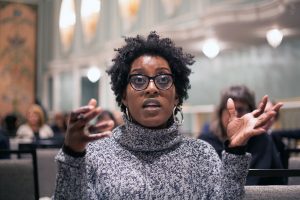
Curator and anthropologist Niama Safia Sandy at the 2017 CAA Annual Conference in New York. Photo: Ben Fractenberg
CAA needs your help to advance the programs and support we provide to the individuals and institutions that comprise the world’s largest international professional community in the visual arts. Bringing innovative new ideas and meaningful experiences to artists, designers, crafters, curators, art historians, critics, students and faculty members is always on the forefront of our minds, but we cannot do it alone.
We have over 9,000 members, but did you know that approximately half of our members are artists, students, retirees, and part-time faculty, who have subsidized memberships and conference registrations?
These members, and all members, have full access to CAA programs such as:
- Professional Development Fellowships and Publishing Grants
- Awards of Distinction
- Professional Development Podcasts
- Online Career Center
- Advocacy, Fair Use, and Standards & Guidelines
- Resources for Academic Art Museum Professionals (RAAMP)
We advocate and design programs for all our members, regardless of how much they pay in membership, and we hope that as in all strong communities, those that can help will.
A donation to the Annual Fund allows CAA to provide the much-needed support for the field at the individual level and to institutions. A contribution gives CAA more power to advocate and serve the ever-changing needs of our members.
Our Travel Fund assists ten students and scholars from across the country and around the world to attend the Annual Conference each year, but gifts directed towards this category will increase that number exponentially.
A contribution to the Publication Fund helps offset the cost to produce the print and online scholarly publications of The Art Bulletin, Art Journal, Art Journal Open, and caa.reviews.
Please consider a tax-deductible donation in either fund category that will help us better serve the visual arts community. No matter what fund category you choose, your support will go a long way in making a difference.
On behalf of the Board of Directors and staff of CAA, I thank you for your generosity.
Best regards,
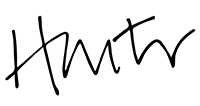
Hunter O’Hanian
Executive Director and CEO
Submit a Proposal for Idea Exchange at CAA 2019
posted by CAA — October 09, 2018
We launched Idea Exchange at the 2018 Annual Conference in Los Angeles in response to members who expressed an interest in holding informal roundtable discussions on topics ranging from fellowship applications and gallery representation to student engagement in the classroom and preserving women artists’s legacies.
We’re offering Idea Exchange again in 2019 and we’re looking for CAA members to serve as discussion leaders.
Propose a topic that you would like to discuss with your colleagues for a sixty-minute roundtable at the conference. It can relate to professional development, teaching, or fellowships. Suggest a discussion around current events, such as the debate surrounding Confederate monuments or the #MeToo movement in the arts. Be creative. The conversations are meant to be lively and engaging. Please submit your Idea Exchange proposals by December 14, 2018.
In order to submit an Idea Exchange topic, you will need to have your member ID and password ready. If you do not have an individual ID number and password or you do not know it, please contact member services by email at membership@collegeart.org or by phone at 212-691-1051, ext. 1.
Idea Exchange will be held in the Cultural and Academic Network Hall during the following times:
Thursday, February 14: 10:30 AM; 12:30 PM; 2:00 PM; 4:00 PM
Friday, February 15: 10:30 AM; 12:30 PM; 2:00 PM; 4:00 PM
Saturday, February 16: 10:30 AM; 12:30 PM
For more information on Idea Exchange, contact Alison Chang at achang@collegeart.org or by phone at (212) 392-4436.
Help Art History Teaching Resources (AHTR) Teach the Importance of Design History
posted by CAA — October 01, 2018
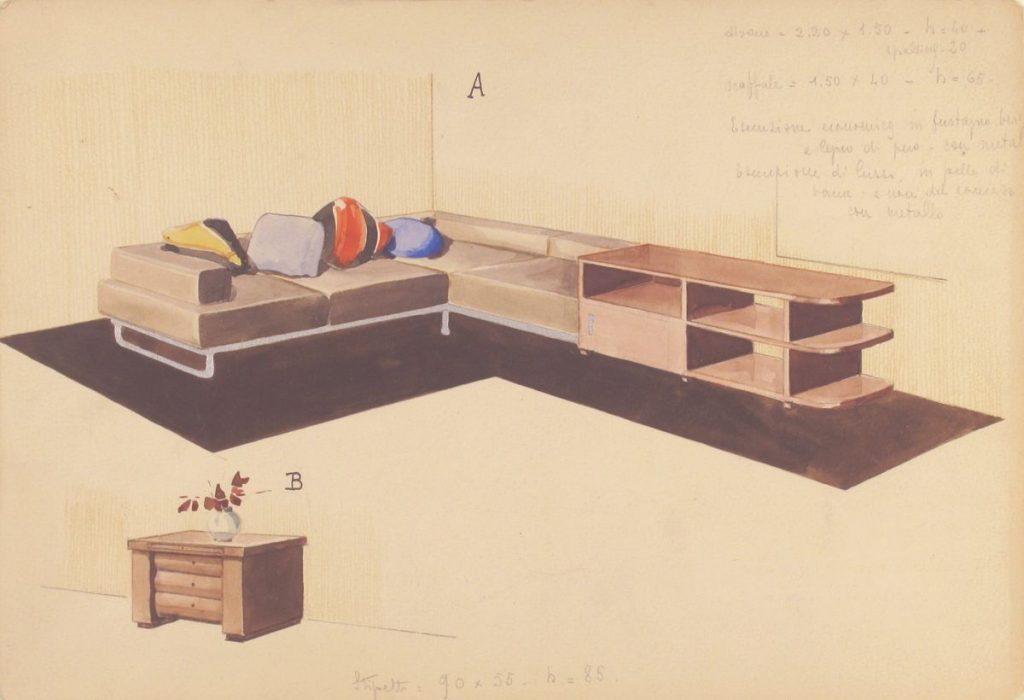
Guglielmo Ulrich, Divano, seoffale, e stipetto [Perspective of L-Shape Sofa and Storage Unit], 1933, watercolor and black and metallic ink, over graphite, sheet: 11 1/8 × 7 9/16 in. (28.2 × 19.2 cm). Collection of the Metropolitan Museum of Art.
ArtHistoryTeachingResources.org
Funding Sought: $4,000
Every day, across thousands of universities and high schools in the US, students learn about the history of art from prehistory to the present. Very rarely is design history incorporated into this curriculum. Art History Teaching Resources (AHTR)—a non-profit teaching resource site in the visual arts—wants to change this.
AHTR has collaborated with CAA’s Committee on Design to propose an initial collection of online teaching resources related to design history of the last two hundred years that will enable university-level and AP instructors to confidently teach them in foundational art and design history survey classes. The resources will be hosted online at arthistoryteachingresources.org in an area clearly marked as “design history” content.
Like AHTR’s existing resources already, the Design History Teaching Resources will include scholarly, well-researched, and peer-reviewed lecture outlines, image clusters, and bibliographies, as well as innovative digital videos and links to other Open Educational Resources (OERs) for students and teachers. The resources will remain freely accessible and open to all under a Creative Commons license.
To realize these resources AHTR needs to raise a modest sum of $4,000. If you might consider supporting this venture with a donation large or small, and would like to see the budget outline, timeline for completion, or any further details about the project, please contact: info@arthistorytr.org
CAA Announces Campus Ambassador Program
posted by CAA — September 24, 2018
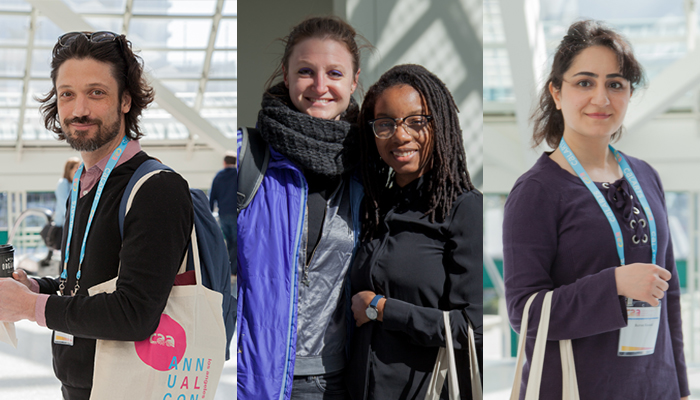
CAA 2018 Annual Conference attendees. Photography by Rafael Cardenas
Students have always been vital to CAA. Our student membership, which is nearly one quarter of our entire membership, has always been vocal, engaged, and eager. This fall we are looking to our students to help carry CAA into the future with the launch of the CAA Ambassador Program.
CAA is seeking Ambassadors in the New York, Boston, and Chicago areas to represent CAA and give short talks about the organization to their fellow classmates and students in nearby schools. The six selected Ambassadors will be compensated for each talk and given a complimentary CAA Annual Conference registration and one-year CAA membership at the student level. Ambassadors will collect feedback at their talks and have check-ins with CAA staff leading the project.
To be considered for the CAA Ambassador role, applicants must be currently enrolled in a visual arts-focused program at a university or college in the New York, Boston, or Chicago area. Applicants should be in their junior year or higher. Master’s degree, Master of Fine Arts, and PhD candidates are encouraged to apply. Familiarity with CAA and its programs is necessary for this role. Candidates should feel enthusiastic about spreading the word about CAA and feel comfortable speaking in front of groups. The Ambassador role is a two-semester commitment (fall and spring) with a maximum of five talks given on campuses each semester.
To be considered for the CAA Ambassador Program, please submit your resume or CV, cover letter expressing your interest, and one reference to Alison Chang at achang@collegeart.org.
Applications will be accepted until the positions are filled.
Hunter O’Hanian in Conversation with Eric Segal, Director of Education and Curator of Academic Programs at the Harn Museum
posted by CAA — September 04, 2018
CAA’s executive director, Hunter O’Hanian, recently visited the Harn Museum of Art in Gainesville, Florida to speak with Eric Segal, the museum’s director of education and curator of academic programs, about the role of academic art museums and Resources for Academic Art Museum Professionals (RAAMP).
A project of CAA supported by the Andrew W. Mellon Foundation, RAAMP aims to strengthen the educational mission of academic museums and their parent organizations by providing a publicly accessible repository of resources, online forums, and relevant news and information.
Watch and read the interview below.
Hunter O’Hanian: Hello everybody. My name’s Hunter O’Hanian and I’m the director of the College Art Association. I’m very pleased today to be with Eric Segal, who is the director of education and curator of academic programs here at the Harn Museum in Gainesville, Florida. Hello, Eric. How are you?
Eric Segal: Hunter, I’m doing well. It’s great to have you here in Gainesville.
HO: Well, it’s absolutely beautiful. It’s been great to be spending time here and to go through the museum. Before we start, tell us a little bit about your background. I know you’ve been a CAA member since you were in graduate school, but tell us a little bit about your professional background.
ES: Sure. CAA since 1993.
HO: Yay.
ES: I actually started my college career as a computer engineering major. So, it was a big change when my sister made me take an art history class and that led me into art history, and I studied American art subsequently at UCLA, Masters.
HO: And, I think you won a Terra award, too.
ES: I was really fortunate to have a Terra award in 1999.
HO: Great.
ES: And that was very exciting for me and helped me in my studies. Following the completion of my doctoral dissertation, I took an assistant professor position here at University of Florida. So, I was in the art history department teaching undergraduate and graduate courses in American art, African American art, illustration and even occasionally about museum theory. Later, in 2010, a position opened up in the museum where I was able to take on museum practice a bit more. That position was the academic programs position, which had just been created as the museum realized it was important to draw closer to the university. At that time, before the position opened up, there were perhaps a few dozen courses using the museum, because there was no one doing the outreach to work with faculty across campus.
Since that time, about 10 years, we’ve maybe increased that tenfold. The number of courses, the number of faculty, the number of disciplines and students using the museum—we’ve been really delighted to expand that quite a bit.
HO: That’s great. So, [the] University of Florida here in Gainesville, about 50,000 students here on campus.
ES: Yes.
HO: You have an art history department here. And do you have a studio arts department as well?
ES: It’s a combined school of art and art history and they’re both very robust. There’s a faculty of about seven in art history and the tens, twenties in art and they’re all great colleagues. In fact, in 2019 we will have the studio art faculty show here at the museum, which comes [around] every five years.
HO: Wonderful. So, the Harn Museum has been around since 1990. Roughly, how big is it? How many square feet is the facility?
ES: The museum is about 26,000 square feet.
HO: That’s big for an academic art museum.
ES: It is. We have all of our storage onsite. We have great galleries devoted to five collecting areas. We collect in African [art], in Asian [art], in photography, in modern and contemporary art. And we have a curator in each area. So, we’re very lucky. Many academic museums don’t have such a robust curatorial staff. And we also have classrooms where we can do teaching, where we can bring objects out from storage in order to connect with academic classes on campus if we have a theme we want to try to address, say, “urban imagery.” It may be better just with works that are in storage, rather than those that happen to be on view at a given time.
HO: And 11,000 objects in the collection?
ES: That’s right.
HO: Wow. And so how do you go about procuring objects for the collection?
ES: Right. So our curators are very active along with our development officer and our director in building relationships. So, we do have an endowment for acquisitions, but many of our acquisitions do come through gifts from donors, and that would be in all areas.
HO: I noticed too in going through the museum with you that you also have a fair number of Florida artists in your collection. Can you speak about some of them?
ES: We have Florida artists from the 19th century through the present. Some of them are former faculty at UF with international and national reputations, and some include folk artists who work locally and are widely collected and whose work reveals unexpected and inspiring perspectives on our own community. So, we have both highly-trained professional artists and amateur or untrained artists.
HO: It seems to me also that you’ve done a lot of work in your role as far as inviting members of the local Gainesville community, people who are not part of the academic campus on or into the museum through different programs. Can you talk generally about how you’ve been programming in trying to bring the local Gainesville community into the museum?
ES: Sure. So, as curator of academic programs, I obviously personally focus a lot on the academic community, but I’m also director of education as you mentioned, and I have a staff with whom I work to engage the community. I also consider that my responsibility as well. We have public programs that I think of as creating layers of access. There’s programs that are traditional museum programs of lectures and educational docent tours, which have immediate appeal to people who are familiar with museums and have a museum-going experience and know they might want to learn something about an exhibition, but we also have our whole range of activities that invite the community in perhaps for a first time. We’re creating museum goers out of our local citizenry.
So, those might be experiences that sound more fun and social, but include informal learning opportunities. We have a museum nights event once a month which is open in the evenings. So, lots of programs such as that, but we also think it’s really important to reach audiences that aren’t even looking at the museum as a possible venue for leisure or art experiences and we find it’s really effective to work with the local public schools. All children go to schools and we’re able to work with them to provide transportation and rich tour experiences and programs that engage children and parents as well. Creating the opportunity to connect with families that might not be thinking of the museum, but may learn from the children that it’s a really welcoming, relevant, and meaningful space.
HO: Overall for the whole museum, how big is the staff here?
ES: The staff, including security and frontline staff, is about fifty.
HO: Wow. Great.
ES: So, it’s pretty robust.
HO: And for academic programs and education, how big is that?
ES: In education, we have six full-time staff and a number of part-time staff who support programs and activities. So, we’re also very lucky. There are smaller museums that are working on a narrower range of staff resources.
HO: What challenges do you see for the education programs here at the Harn Museum going forward?
ES: Well, you did ask about our connecting with community audiences and our challenge is to continue to grow that and be relevant and to let audiences know that we are welcoming. We want to reach audiences that have not seen themselves in museums. So, diversity in our audiences is something we’ve done a lot to improve with by partnering with local groups, with activists, with people in different communities. We’ve done a lot to improve our diversity of audiences, but we’re still expanding there. In staff, that’s another area where we really need to work hard and we have focused part of our strategic plan extension into 2019 to focus on developing new ways to build diverse staff members across the museum, including in senior staff, which as we know in museums in the United States is a real problem.
HO: If you were speaking to someone else in your position, maybe in a more rural location or a smaller facility, and they wanted to engage the community more, what advice would you give them?
ES: That’s a great question. I think that it’s really important to let audiences know that they’re welcome and to my mind, the best way to get that message out there is by being out in the community, attending community fora on relevant topics, being part of discussions of education and educational resources, being part of discussions on how universities are trying to engage—the local university or college may be trying to engage the community, both on campus and in the community. Being a face in the community makes you somewhat approachable and starts to build the relationship that’s hard to build with an advertisement in the paper that says, “Everyone’s welcome. Admission is free”. Hopefully.
So, that would be one of the first steps that I think I would try in that position is to really be part of the community and to make contact with community leaders who already have authentic connections to different members of different areas of the community.
HO: We’re going to be recording some video practicum about different areas in the museum and we’ll get into some more of those details later, but it also seems as if you’ve developed good relationships with different departments within the college itself. Can you speak a little bit about doing that and how you go about being successful there?
ES: Some of our failures in doing that have been—not that I wouldn’t continue to do it—you know, I go and give a talk to the faculty senate and I send a letter to all faculty and I get a lot of emails back, if I’m lucky, that say, you know, I saw your email but I didn’t read it last year because you sent it to everyone. So, the hard work is making individual contacts either by email but also being out there again on campus. I try to serve on committees, be it in the international center or on undergraduate curriculum, wherever it might be useful, seeing that the museum could be a resource that can be built into emerging programs and projects. So, being at the table is important. And then building the individual connections to faculty. One faculty member in a language and literature department can be your ambassador to other faculty members.
HO: And, of course you’re familiar with RAAMP resources for academic art museum professionals, and the Harn has been one of the original stakeholders, and this has been a great project that CAA has worked on with the Mellon Foundation.
ES: Yes.
HO: We’ve been very happy with the success. As a resource out there, how have you been able to use RAAMP and also were there any changes you’d like to see to it or more things you’d like to see us add to it?
ES: Yes. RAAMP is a great resource. It’s been wonderful to see it grow and the website has, for anyone who hasn’t visited it recently, really been improved in the last year, making it searchable in a way that it wasn’t before. So, it’s a resource where you can actually find the materials that are there pretty easily now and that makes it especially useful. So, for me, it’s been great as a source of inspiration when I come up against a problem such as “How do I…?” I haven’t found this one yet, but one of my problems is how do I connect with low temperature physics? I’ve never solved that problem, but when someone posts that to RAMP, that’s where I’m going find it.
HO: Great. So, for any of you out there who have an answer to that quick question as to how to deal with low temperature physics, please post it on RAAMP now.
ES: That’s right. But, it’s really a great source of inspiration [for] problem solving and models that exist out there. It’s also I think increasingly going to continue to serve the role of [a] point for conversations, which is something that I’m really looking forward to, because sometimes someone hasn’t posted on low temperature physics, but they may have already done it. And so it’s a chance to get feedback and ideas. I’m also really looking forward to in the future ideas about building diversity, as we discussed earlier. How it’s being pursued at other museums, both in terms of audiences but also in terms of staff. I think as a community academic program officers in museums need to come together to build the pipeline of museum professionals. That includes recruiting students when they’re young. I’ve been working with high school students in the past week to just tell them that museums are a career and that’s important.
It includes supporting internships. I think that discussion can happen in RAAMP about how we can sort of strategically create a pool that we’re all going draw on to diversify our staff. I’m also looking forward to learning from RAAMP more about ideas for academic programs working with development offices.
HO: Interesting. The fundraising piece.
ES: Yes. The fundraising piece. We’re all challenged in our budgets. In the past year, we’ve developed a program on early learning that we built with the college of education, and we built a really robust project, and someone said: “You need to do a video for this.” And that video has been helpful for us in developing private funds to continue to pursue this program that provides education for headstart students.
HO: Which is great, because it gives potential funders the opportunity to see what the programs are really about and be able to see that.
ES: It is. And that’s the kind of thing I’d love to share on RAAMP and also learn from others their strategies for taking our programs and having them be tools for building our funding.
HO: Yes. I’ve been recently reviewing the session proposals for the upcoming CAA conference in New York in February of 2019 and there are a lot of sessions that are coming up for professionals in academic art museums, because I do think it’s a growing field that a lot of PhD students or PhD holders and Masters will be going into it in the future. So, there will be a lot at this year’s conference in February.
ES: That’s really great to hear. And I hope that non-museum professionals, hope that artists and art historians will attend those as well, because their voices are really useful to be part of those conversations that art museum professionals are having. I was thinking about the sort of professionalization that another area of RAAMP is going help us connect on is going to be evaluation. Museums are always challenged in terms of evaluation. We know it’s important to prove that what we do is effective. Evaluation is time-consuming or expensive or both, and sharing expertise and ideas in that area I think is going to be something that’s going to really help us to build our case in the future.
HO: Yes, I mean, ultimately all museums are educational institutions, and we have to be able to quantify how that happened.
ES: I think that is the case.
HO: Eric, thank you so much for your time here. It’s been great to tour the museum and I really have appreciated it. And so good luck with all your work going forward.
ES: Thank you, Hunter, for sharing your interest of the museum with our RAAMP audiences.
An Interview with Jim Hopfensperger, the New President of CAA
posted by CAA — May 24, 2018
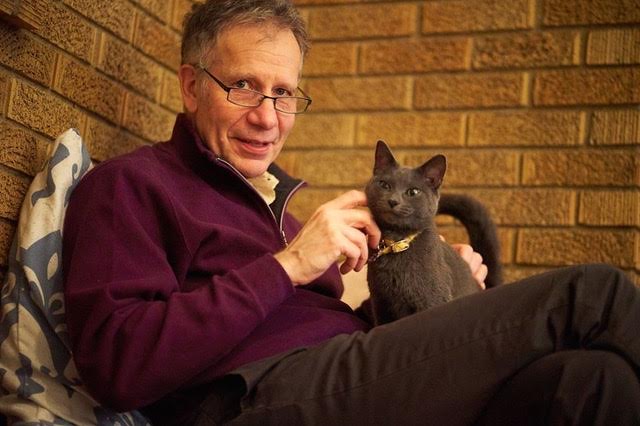
Jim Hopfensperger at home.
As of this month, Jim Hopfensperger, professor of art at Western Michigan University’s Gwen Frostic School of Art, is CAA’s new president for the 2018-2022 term. As a professor and artist with a wealth of experience, we thought it would be a great opportunity to ask Jim his thoughts on CAA and the field at-large. CAA media and content manager Joelle Te Paske spoke with him earlier this month.
JTP: Hi Jim! Thanks so much for speaking with me. How are you?
JH: Very well, Joelle. Thank you so much for taking the time to visit!
JTP: To get us oriented, where did you grow up?
JH: My spouse, Jane, and I were raised in the upper Midwest. While career choices took us to Pennsylvania and Massachusetts, we returned “home” to Michigan eighteen years ago to be nearer aging family members.
JTP: And what did you study?
JH: I was educated as a craftsperson, working primarily in non-ferrous metals such as silver, gold, and copper. During a sabbatical leave from my faculty position at Penn State University in the early 1990s, I was presented the opportunity to work in a furniture studio in Massachusetts. Within a few weeks I was totally hooked, gifting my metal working tools to a younger artist and moving forward as a furniture maker.
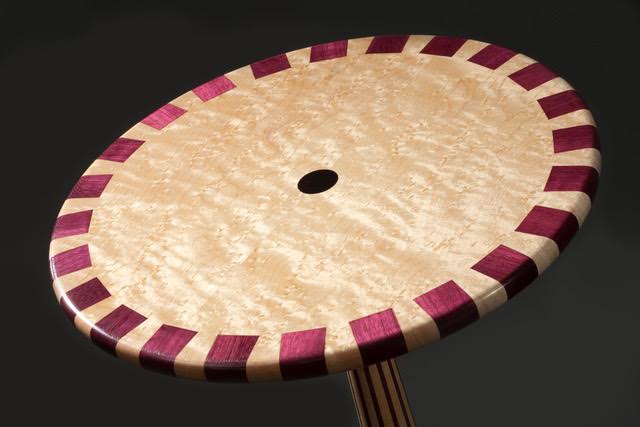
Jim Hopfensperger, Shaker Purple, 2012
JTP: What drew you to the work you do now?
JH: I am drawn to how creating art/design objects—one-at-a-time and by hand—reinforces and reaffirms what it means to be a human being. Thinking with my hands, my eyes, and my mind to conceive well-designed and useful articles makes me feel whole. Perhaps I am a kinesthetic thinker/learner? It also seems possible that, for better and for worse, my sense of self is simply anchored in making things. The non-existent term “neuroceutical therapy” comes to mind!
JTP: What is exciting to you as the incoming CAA president?
JH: The forces of change are in motion all around us. It is a truly exhilarating time to be in the business of living!
As for CAA, a raft of research suggests that healthy organizations prosper when focusing efforts along two key pathways: 1) identifying and strengthening essential core competencies and 2) systematically exploring future capacities. This means sustaining CAA’s outstanding programs and services while simultaneously identifying the organization’s next purposes. Full attention to both matters seems essential if we are to extend a highly distinguished history of advocacy for artists, art historians, scholars, curators, critics, designers, collectors, and educators. I am grateful for this opportunity and excited about the work ahead.
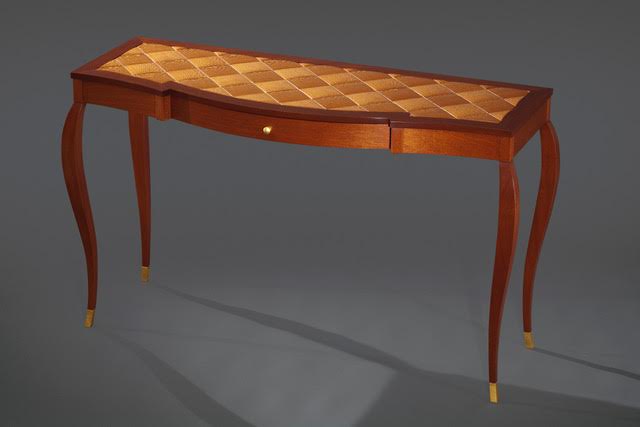
Jim Hopfensperger, Deliberation No. 7, 2005
JTP: What work has been done over the past few years that you would like to build on? What would you like to see happening at CAA in the next year? How about in the next ten?
JH: Clearly, CAA remains an eminent learned society. At the same time it is increasingly fulfilling its potential as a professional association that serves members across educational, curatorial, scholarly, and creative pursuits. In the short term I am confident CAA will remain a strong association and identify more ways to support members in their professional lives.
Over the next few years a pivot toward some key constituencies might make strategic sense. Those include 1) the burgeoning ranks of contingent employees upon whom educational and cultural institutions have become increasingly reliant; 2) the large number of design and new/emerging media practitioners graduating from art and design programs; and 3) the community of international scholars, artists, and designers steadily advancing global perspectives. I look forward to working with CAA members, staff, board, and other stakeholders to map a future wherein these colleagues will be well served.
JTP: What has been a memorable professional moment for you at a CAA Annual Conference?
JH: I am deeply invested in the fellowship aspects of CAA. My fondest memory involves mentoring in the Professional Development Workshops at the Annual Conference in 2000. One my mentees was, as I, trained as a metalsmith. We worked closely after that conference to identify strategies for achieving his professional goals, and he eventually accepted a splendid academic position. In return for my service, and for each of the past eighteen years uninterrupted, he has gifted to me a handcrafted metal ornament to hang on our family holiday tree. Simply precious! (And if you are reading this Professor James Thurman, a wholehearted “Thank You!” is long overdue.)
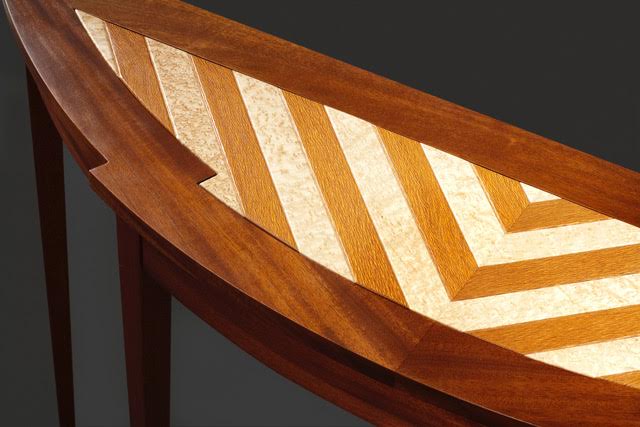
Jim Hopfensperger, Deliberation No. 9, 2013
JTP: What would you say is the number one challenge facing higher education?
JH: Excellent question. My two cents: Adapting to the startling, inevitable pace of cultural and technological change is an operational necessity. Yet, communicating the value of an educated populace appears to be our most immediate and pressing challenge. Making the case for the causal relationship between educational opportunities and the ascendance of an increasingly ethical, moral, and empathetic society is job one. In the absence of such a mission statement, it is not difficult to imagine financial or economic ‘values’ easily filling the void.
The logical outcome might then resemble Oscar Wilde’s timeless quip about a cynic being ‘a man who knows the price of everything and the value of nothing.’
JTP: Do you have a favorite artwork?
JH: I have a keen interest in all forms of applied design—dynamic and surprising buildings, objects, communications, products, and processes. However, and for reasons I am not fully able to explain, my favorite artwork is Monet’s Four Trees in the Met’s collection. This quiet little companion and I visit perhaps once every 12 to 24 months. Invariably, I leave our encounters refreshed and restored.
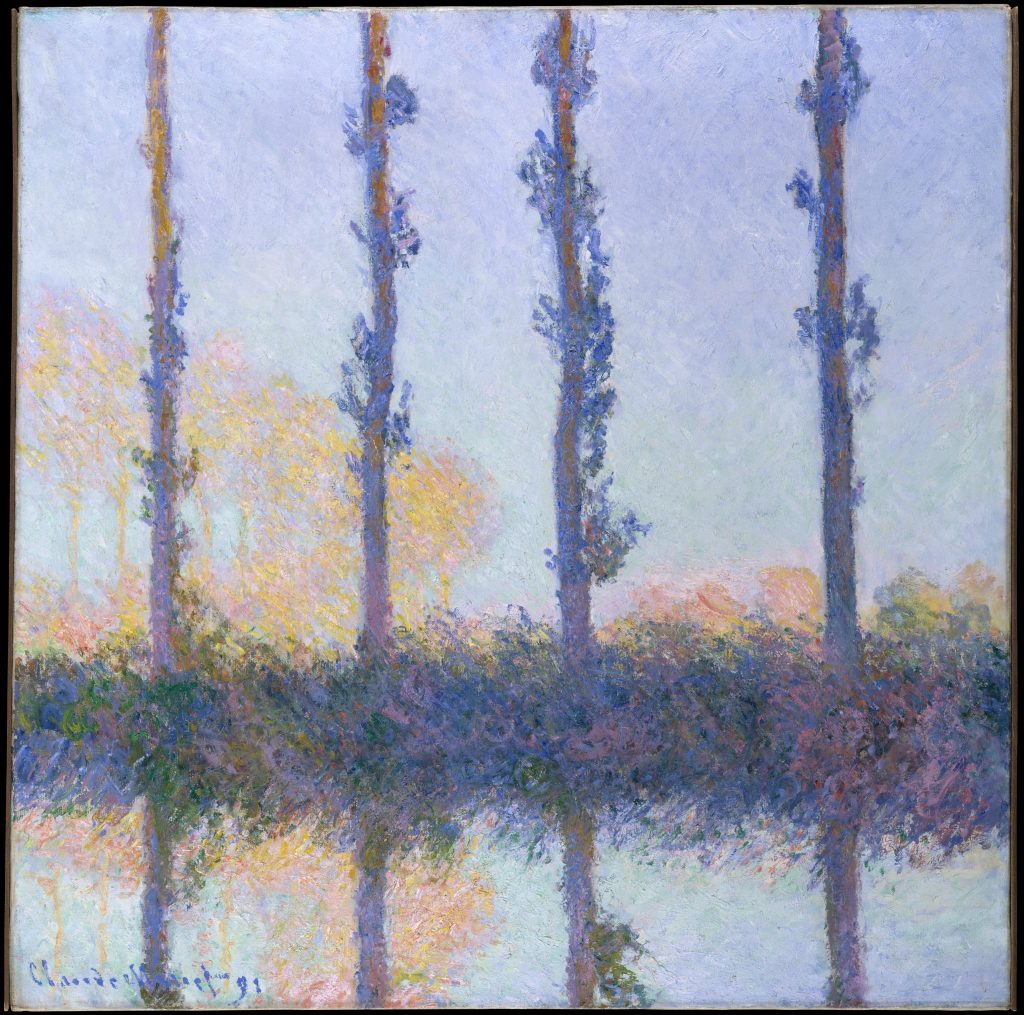
Claude Monet, The Four Trees, 1891, oil on canvas, 32 1/4 x 32 1/8 in. (81.9 x 81.6 cm) Collection of The Metropolitan Museum of Art. Image: Wikimedia Commons
JTP: What about a favorite book?
JH: Much of my reading over the past decade can be described as a search for serviceable maps of the human mind, followed by rubbernecking at accidents caused by irrational behaviors. Daniel Kahneman’s Thinking Fast and Slow is a fine example of the former, the type of mind mapping I find highly addictive. Kahneman’s lenses for understanding our extraordinary capabilities, while simultaneously identifying those pesky faults and deep biases that accompany human thought and action, help structure my own thinking. In a related way writings on decision-making in everyday life are equally intriguing and useful. Charles Duhiggs’s The Power of Habit, Dan Ariely’s Predictably Irrational, Keith Payne’s The Broken Ladder successfully illustrate complexities and contradictions when/where supposedly rational thoughts and human actions intersect, often to hilarious and/or tragic effect—endlessly fascinating stuff!
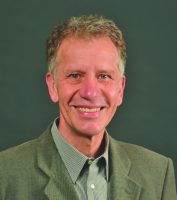
Jim Hopfensperger is a professor of art at Western Michigan University’s Gwen Frostic School of Art where he teaches foundation art. Jim’s art works have been shown nationally and internationally in over 100 exhibitions at venues including the Detroit Institute of Arts, Nelson-Atkins Museum of Art, Auckland Memorial Museum, Lever House, University of Iowa Museum of Art, University of Oregon Museum of Art, State Museum of Pennsylvania, North Carolina Museum of History, and National Ornamental Metals Museum.
Jim’s past appointments include serving as Senior Associate Dean in the College of Fine Arts at Western Michigan University, Chair of the Department of Art & Art History at Michigan State University, and Head of the Studio Art Program at The Pennsylvania State University. He has also taught at the Massachusetts College of Art, University of Massachusetts-Dartmouth, Skidmore College, University of Michigan, and North Carolina State University.
Jim is Past President of the National Council of Arts Administrators, and is an accreditation visitor for the National Association of Schools of Art and Design. He earned a MFA from University of Michigan, a MA from University of Illinois at Urbana-Champaign, and a BA from Michigan State University.
CAA at 2018 Arts and Humanities Advocacy Days in Washington, DC
posted by CAA — March 16, 2018
CAA staff in Washington, DC (left to right): Joelle Te Paske, media and content manager, Alison Chang, sponsorship and partnership manager, Aakash Suchak, grants and special programs manager, Hunter O’Hanian, executive director, and Nick Obourn, director of communications, marketing, and membership.
Earlier this week CAA staff traveled to Washington, DC for Americans for the Arts’s Arts Advocacy Day and National Alliance for the Humanities’s Humanities Advocacy Day.
After a day of breakout sessions and briefings on Monday, staff visited congressional offices on Tuesday to advocate for continued funding for NEA, NEH, IMLS, CPB, and support for the arts, humanities, and higher education. See our on-the-ground updates.
We visited 18 congressional offices representing three different states, with positive responses from both Democrats and Republicans. We meet with staff or dropped off materials with:
New York
Sen. Chuck Schumer (D-NY)
Rep. Grace Meng (D-NY 6th District)
Dropped off materials with Rep. Nydia Velázquez (D-NY 7th District)
Dropped off materials with Rep. Hakeem Jeffries (D-NY 8th District)
Rep. Yvette Clarke (D-NY 9th District)
Rep. Jerrold Nadler (D-NY 10th District)
Dropped off materials with Rep. Eliot Engel (D-NY 16th District)
Rep. Nita Lowey (D-NY 17th District)
Rep. Sean Maloney (D-NY 18th District)
Wisconsin
Sen. Ron Johnson (R-WI)
Rep. Mark Pocan (D-WI 2nd District)
Rep. Sean Duffy (R-WI 7th District)
Rep. Mike Gallagher (R-WI 8th District)
Connecticut
Sen. Richard Blumenthal (D-CT)
Rep. John Larson (D-CT 1st District)
Rep. Joe Courtney (D-CT 2nd District)
Rep. Jim Himes (D-CT 4th District)
Rep. Elizabeth Esty (D-CT 5th District)
Learn more about Advocacy Days below.
ARTS ADVOCACY DAY
March 12 – March 13, 2018
Hosted by Americans for the Arts
Arts advocates from across the country convene in Washington, DC for Americans for the Arts’s annual Arts Advocacy Day each year. Arts Advocacy Day brings together a broad cross section of America’s cultural and civic organizations, along with more than 700 grassroots advocates from across the country, to underscore the importance of developing strong public policies and appropriating increased public funding for the arts. Learn more.
HUMANITIES ADVOCACY DAY
March 11 – March 13, 2018
Hosted by National Alliance for the Humanities
Humanities Advocacy Day provides the opportunity to connect with a growing number of humanities advocates from around the country. Together, advocates will explore approaches to year-round advocacy on college campuses and in local communities while also preparing for Capitol Hill visits. On March 13, they will visit House and Senate offices to make a persuasive case for federal funding for the humanities. Learn more.
WHY DID CAA ATTEND?
For two years in a row, we’ve offered our complete and total opposition to efforts to eliminate funding for the National Endowment for the Arts (NEA), the National Endowment for the Humanities (NEH), and other domestic programs that fund education, arts, and humanities initiatives, as outlined in the 2018 and 2019 White House budget proposals.
Over the last year, we’ve also solicited feedback from our members on a variety of issues that impact the arts, humanities, and higher education, including:
- Gun control and the proposal to arm teachers
- Tax reform and its effect on higher education
- Embracing and supporting diverse voices in the arts
- Hiring standards for part-time faculty
- Removing or preserving Confederate monuments
- The Muslim Travel Ban
For more on our advocacy efforts, click here.
We encourage you to be vocal about your support for the arts and humanities. Click here to access the CAA Arts and Humanities Advocacy Toolkit.
CAA Goes to Washington
posted by CAA — March 07, 2018

See live updates on Twitter and Instagram
Early next week, staff members from CAA will be attending Arts Advocacy Day and Humanities Advocacy Day in Washington, DC.
ARTS ADVOCACY DAY
March 12 – March 13, 2018
Hosted by Americans for the Arts
Arts advocates from across the country convene in Washington, DC for Americans for the Arts’s annual Arts Advocacy Day each year. Arts Advocacy Day brings together a broad cross section of America’s cultural and civic organizations, along with more than 700 grassroots advocates from across the country, to underscore the importance of developing strong public policies and appropriating increased public funding for the arts. Learn more.
HUMANITIES ADVOCACY DAY
March 11 – March 13, 2018
Hosted by National Alliance for the Humanities
Humanities Advocacy Day provides the opportunity to connect with a growing number of humanities advocates from around the country. Together, advocates will explore approaches to year-round advocacy on college campuses and in local communities while also preparing for Capitol Hill visits. On March 13, they will visit House and Senate offices to make a persuasive case for federal funding for the humanities. Learn more.
WHY IS CAA ATTENDING?
For two years in a row, we’ve offered our complete and total opposition to efforts to eliminate funding for the National Endowment for the Arts (NEA), the National Endowment for the Humanities (NEH), and other domestic programs that fund education, arts, and humanities initiatives, as outlined in the 2018 and 2019 White House budget proposals.
Over the last year, we’ve also solicited feedback from our members on a variety of issues that impact the arts, humanities, and higher education, including:
- Gun control and the proposal to arm teachers
- Tax reform and its effect on higher education
- Embracing and supporting diverse voices in the arts
- Hiring standards for part-time faculty
- Removing or preserving Confederate monuments
- The Muslim Travel Ban
For more on our advocacy efforts, click here.
We encourage you to be vocal about your support for the arts and humanities next week (and beyond!). Click here to access the CAA Arts and Humanities Advocacy Toolkit.
Call for CAA Member Feedback: Measuring College Learning in Art History
posted by CAA — February 16, 2018
In 2013 the Social Science Research Council (SSRC) launched the Measuring College Learning (MCL) project as a way to engage faculty in the effort to understand and improve student learning in their discipline through development of better tools for assessment in higher education. CAA recently partnered with the SSRC to create an MCL-Art History panel that would outline learning objectives for introductory art history courses, including identifying essential concepts and competencies that demonstrate foundational knowledge of the discipline. The MCL-AH panel convened in July and December 2017 to produce a draft document.
The MCL-Art History panel will host an open forum at the CAA Annual Conference from 2:00-3:30 PM on Friday, February 23rd in Room 511A of the Los Angeles Convention Center to collect CAA member feedback on its initial draft of core learning goals. The panel plans to share the draft document, solicit input and observations, and respond to questions from the community. CAA members are also invited to review the draft document and share observations before, during, and after the annual conference (until March 31, 2018).
Link to MCL-AH Document: http://highered.ssrc.org/wp-content/uploads/2018.02-MCL-in-Art-History-Report-for-CAA.pdf
CAA Member Feedback to: edick@ssrc.org
Background on the Measuring College Learning Project
In MCL projects faculty and other experts come together to consider what students should learn in their majors and how that learning should be measured. Panels of experts from six disciplines participated in the first iteration: biology, business, communication, economics, history, and sociology. Several national disciplinary associations—including the American History Association, the American Sociology Association, and the National Communication Association—were actively involved in this project. The culmination of this work was the publication of Improving Quality in American Higher Education: Learning Outcomes & Assessments for the 21st Century (Jossey Bass, 2016). More information and resources from this project are available on-line for free download at: http://highered.ssrc.org/projects/measuring-college-learning-project/.
MCL-Art History Panel Members:
Richard Arum, University of California-Irvine, SSRC Senior Academic Advisor
Cole Edick, SSRC Program Assistant
Christine Havice, Kent State University
Richard Lubben, Lane Community College, CAA Education Committee
Elisa Mandell, California State University Fullerton, CAA International Committee
Walter Meyer, Santa Monica College, CAA Professional Practices Committee
Chika Okeke-Agulu, Princeton University, CAA Board of Directors
Stephanie Smith, Youngstown State University
MCL-Art History Co-Chairs:
Virginia Spivey, Independent Scholar and Consultant, CAA Education Committee
Andy Schulz, Penn State University, CAA Board of Directors
Jim Hopfensperger, Western Michigan University, CAA Board of Directors
CAA Statement on the 2019 White House Budget Proposal
posted by CAA — February 12, 2018
Earlier this afternoon, the White House released its 2019 Budget Proposal. The $4.4 trillion budget outlines deep cuts in domestic programs that fund education, arts, and humanities initiatives, while increasing military spending.
“By zeroing out the budgets for the NEH, NEA and similar agencies that support the arts, humanities and education, the President has shown again that he cares more about tax cuts for the wealthy than supporting an American cultural heritage, funded though these agencies,” said Hunter O’Hanian, CAA’s executive director. “Thankfully, a bipartisan group of Congressional members, those with the real financial authority, have Americans interests at heart and they will reject the President’s draconian proposals.”
The entire budget proposal adds $984 billion to the federal deficit in the next year and in total adds $7 trillion to the deficit over the next 10 years.
Partial list of programs slated for elimination:
- NEA
- NEH
- IMLS
- CPB
- Corporation for Travel Promotion (Brand USA)
- Delta Regional Authority
- Denali Commission
- Northern Border Regional Commission
- Woodrow Wilson Center
- S. Interagency Council on Homelessness
- S. Trade and Development Agency
- Chemical Safety and Hazard Inspection Board
- Under SNAP: “Proposals are also included to eliminate funding for State performance bonuses and for SNAP nutrition education grants…”
- Economic Development Administration
- Contingency Fund
We call on our members and those who believe in the importance of the arts, humanities, and education to act now. The most effective way to make your voice heard is through your local representatives. Call. Email. Write letters.
Congress has this budget in their hands and now is the time to let them know you support the programs it seeks to eliminate.
Click here to access the CAA Arts and Humanities Advocacy Toolkit.
We look forward to discussing budget advocacy at our Annual Conference in Los Angeles, February 21-24.



